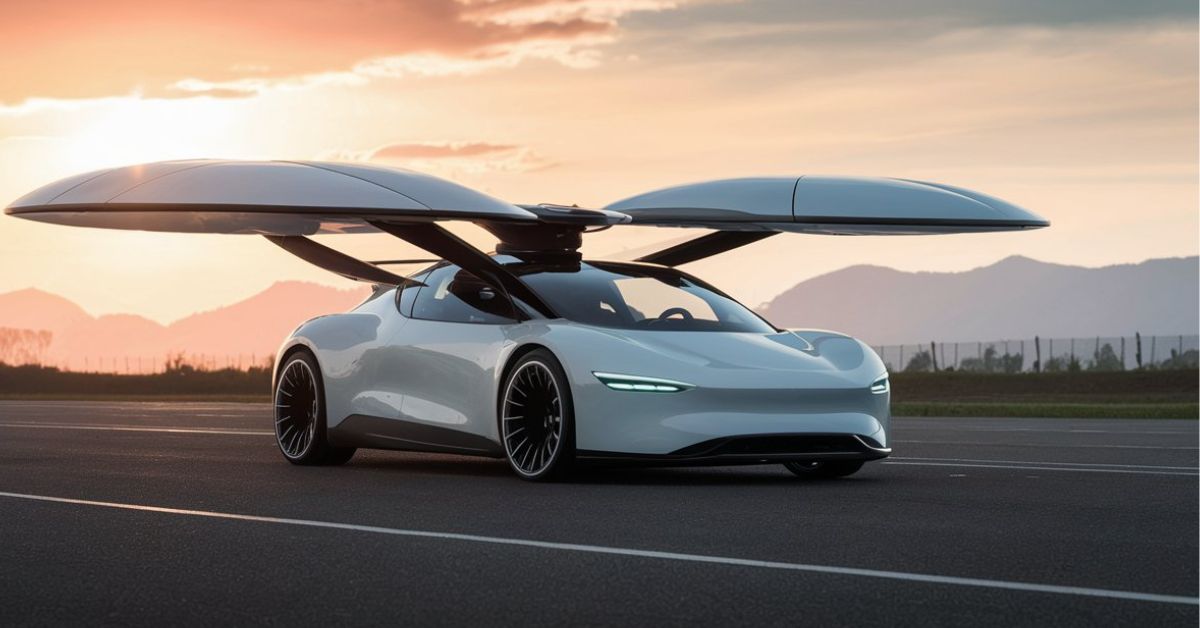In the ever-evolving landscape of transportation, a revolutionary technology is poised to soar above the challenges of urban congestion – electric flying cars. With an estimated 60% of the world’s population projected to reside in cities by 2030, the need for innovative mobility solutions has never been more pressing. First Electric Flying Cars Talking to The Skies.
Breaking Boundaries: The Advent of Electric Aviation
Aviation has long been a picture of human ingenuity, however, its reliance on fossil fuels has come at an enormous environmental cost. However, the latest breakthroughs in electric-powered propulsion structures pave the way for a sustainable future. Companies like Joby Aviation, Lilium, and Archer Aviation are at the leading edge of this revolution, growing electric-powered vertical take-off and touchdown (eVTOL) planes designed for metropolis air mobility. First Electric Flying Cars Talking to The Skies.
From Concept to Reality The Journey of Electric Flying Cars
The idea of flying motors has captivated human creativity for many years, appearing in science fiction films and futuristic standards. Today, this imaginative and prescient idea is hastily becoming a fact. Pioneers like Google co-founder Larry Page and entrepreneur Sebastian Thrun have invested heavily in agencies like Kitty Hawk and Wisk Aero, respectively, propelling the development of electric air taxis and private air cars.
“We’ve been dreaming about flying cars since the beginning of the 20th century. Now we’re making that dream a reality.” – Sebastian Thrun, CEO of Kitty Hawk
This collaborative effort between engineers, designers, and policymakers has transformed electric flying cars from a mere concept into tangible prototypes and working models, paving the way for a future where urban air mobility is within reach.
Navigating the Future Challenges and Opportunities of Electric Air Travel
While the possibility of electrically flying automobiles is exhilarating, it additionally presents a unique set of challenges. Integrating those motors into present air traffic systems and urban landscapes will require careful planning and coordination. Concerns surrounding protection, noise pollution, and infrastructure requirements ought to be addressed to ensure an unbroken transition.
However, the possibilities provided by this era are equally compelling. Electric flying motors can relieve visitors’ congestion, reduce carbon emissions, and boost accessibility to faraway or underserved areas. By leveraging superior technology like self-sufficient flight structures and vertical take-off and landing abilities, these vehicles may want to revolutionize urban transportation. First Electric Flying Cars Talking to The Skies.

Sustainability Soaring High: the Environmental Impact of Electric Flying Car
One of the most tremendous blessings of electrical flying cars is their capacity to reduce the environmental impact of transportation. Unlike conventional gas-powered automobiles and conventional planes, these innovative aircraft operate on electric vehicles, disposing of direct carbon emissions and contributing to improved air nice in urban regions.
According to a study by the University of Michigan, electric air taxis could reduce greenhouse gas emissions by 94% compared to gasoline-powered vehicles used for ride-sharing services. Additionally, the noise pollution associated with electric propulsion systems is significantly lower than that of traditional aircraft, making them well-suited for urban environments.
Technology Takes Flight the Engineering Behind Electric Air Mobility
At the heart of electric flying cars lies a remarkable convergence of cutting-edge technologies, including:
- Electric Motors: Powerful and efficient electric motors provide the propulsion needed for vertical take-off and landing, as well as sustained flight.
- Batteries: The advanced lithium-ion battery era allows longer flight instances and accelerated range, overcoming one of the most important boundaries of early electric aircraft.
- self-sufficient flight systems: state-of-the-art independent flight structures permit particular navigation, impediment avoidance, and safe operation, even in dense urban environments.
These technologies work in tandem, enabling electric flying cars to achieve vertical take-off and landing (VTOL) capabilities. Which are crucial for urban air mobility. By eliminating the need for runways, these vehicles can operate from designated vertiports or even rooftops, reducing their physical footprint. And making them more accessible to urban dwellers.
The Promise of Urban Air Mobility Electric Flying Cars in Urban Landscape
Imagine a world where commuters can seamlessly transition from ground transportation to air travel, bypassing gridlocked streets and highways. This is the vision of urban air mobility, and electric flying cars are poised to play a pivotal role in shaping this future.
- Electric Motors: Powerful and efficient electric motors provide the propulsion needed for vertical take-off and landing. As well as sustained flight.
- Batteries: The advanced lithium-ion battery era permits longer flight times and elevated range. Overcoming one of the principal barriers to early electric-powered planes.
- Autonomous Flight Systems: Sophisticated autonomous flight systems allow for precise navigation, obstacle avoidance, and safe operation, even in dense urban environments.
These technologies work in tandem, enabling electric flying cars to achieve vertical take-off and landing (VTOL) capabilities, which are crucial for urban air mobility. By eliminating the need for runways, these vehicles can operate from designated vertiports or even rooftops, reducing their physical footprint and making them more accessible to urban dwellers.
Regulatory Skyline Navigating the Legal Landscape of Electric Air Transportation
As with all emerging generations, the advent of electrical flying vehicles comes with a unique set of regulatory challenges. Aviation authorities and governing bodies are actively developing guidelines and standards to ensure the safe integration of these vehicles into existing airspace.
within the United States, the Federal Aviation Administration (FAA) has hooked up the included Pilot application (IPP) to collaborate with industry partners and facilitate the improvement of city air mobility. Furthermore, the European Union Aviation Safety Employer (EASA) has released its special condition for Small-class VTOL aircraft to provide a regulatory framework for electric-powered flying automobiles.
These efforts aim to address critical areas such as airworthiness certification, pilot licensing, air traffic management, and infrastructure requirements, ensuring that the integration of electric flying cars into the skies is safe, efficient, and compliant with established regulations.
Beyond Sci-Fi: How Electric Flying Cars are Reshaping the Future of Mobility
The advent of electric flying cars represents a paradigm shift in how we perceive and experience mobility. This technological revolution has the potential to redefine transportation, urban living, and even societal norms. First Electric Flying Cars Talking to The Skies.
From Fiction to Fact: Electric Flying Cars as a Solution to Urban Congestion
The advent of electric flying automobiles represents a paradigm shift in how we understand and experience mobility. This technological revolution has the potential to redefine transportation, urban living, and even societal norms.
From Fiction to Fact: Electric Flying Cars as a Solution to Urban Congestion
Circling back to the preliminary project of urban congestion, electric-powered flying cars provide a compelling solution.
By leveraging the 0.33 measurement of city airspace, these automobiles can alleviate site visitors on the floor. And provide a quicker, more green method of transportation.
Towns like Los Angeles, recognized for its notorious traffic jams, are already exploring the opportunity of integrating electric air taxis into their transportation atmosphere. in addition, Singapore has partnered with companies like Volocopter and Skyports to establish a framework for urban air mobility, positioning itself as a pioneer in this emerging industry.
“we’re not just working on a plane; we are operating on a completely new way of mobility to transform cities for the better.” Florian Reuter, CEO of Volocopter.
By embracing this technological revolution, urban dwellers could soon experience a future where commuting is no longer a time-consuming ordeal but rather a seamless and efficient journey through the skies.
Conclusion
The creation of electrical flying vehicles isn’t always merely a technological achievement; it represents a paradigm shift in how we understand and revel in mobility. As these innovative vehicles take to the skies, they can reshape urban landscapes, alleviate site visitors’ congestion, and contribute to a greater sustainable destiny.
While demanding situations remain, the collaborative efforts of engineers, designers, and policymakers are paving the way for a future where urban air mobility is a reality. As we witness this variation spread, it’s essential to include the pleasure and possibilities that electric flying automobiles bring, while additionally addressing the necessary regulatory and infrastructure requirements.
Within the phrases of visionary entrepreneur Elon Musk, “The destiny is going to be mind-blowing. We are virtually going for you to do matters that were technology fiction in the past, like flying automobiles.” As we leap into this new era of mobility. It is time to fasten our seatbelts and put them together for a journey that will redefine our notion of what’s viable.
FAQs
Ans: Electric flying cars, also known as electric vertical takeoff and landing (VTOL) aircraft, are vehicles designed to take off. And land vertically like a helicopter but operate with electric propulsion systems.
Ans: Electric flying cars utilize electric motors and batteries to power rotors or propellers, enabling vertical takeoff and landing. They typically have multiple rotors or propellers for stability and redundancy.
Ans: Safety is a top priority for electric flying car manufacturers. These vehicles undergo rigorous testing and certification processes to ensure their safety. Additionally, many designs incorporate capabilities together with redundant structures and autonomous flight abilities to enhance protection.
Ans: The range of electric flying cars varies depending on factors such as battery capacity, aerodynamic design, and payload. Some models are designed for short urban hops, while others aim for longer intercity journeys.
Ans: Operating an electric flying car will likely require training and certification similar to piloting traditional aircraft. Additionally, autonomous flight features may make operations more accessible to a broader range of users in the future.











